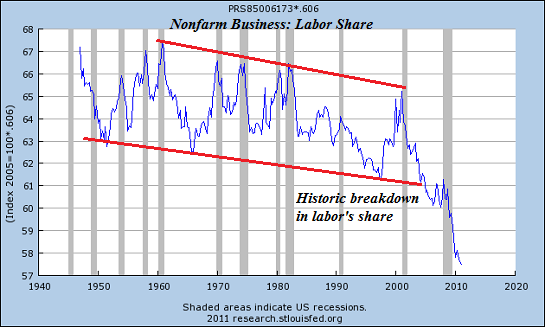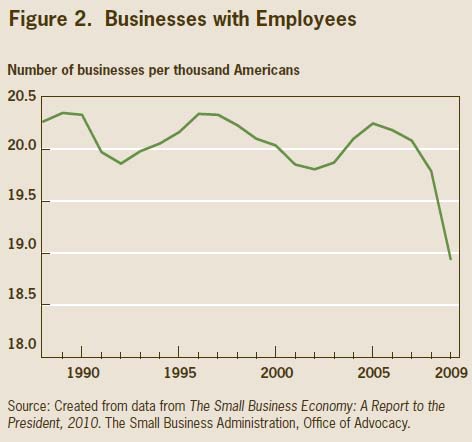Technology, like Nature itself, has no
emotional stake in what is creatively destroyed.
We all know the Federal Reserve is terrified
of deflation, because they keep telling us that deflation is the
equivalent of death and inflation is the equivalent of oxygen.What
they fail to mention is that inflation is only oxygen for debtors
barely able to service their debt and those who profits from debt,
i.e. bankers and financiers.
For everyone earning a wage or salary,
inflation is the equivalent of death by a thousand cuts and deflation
is the elixir of life. When prices decline, our money goes
further, i.e. our purchasing power increases.
Only bankers, governments and other
parasites that live off the carrion of debt fear deflation and try to
destroy the purchasing power of wages with everything in their
power. The irony of all the parasites pushing inflation as
the cure-all is the only real cure-all to our present stagnation and
decline is the complete renunciation/write-off of unpayable debts, a
systemic bankruptcy that rights the ship of state and the economy by
writing off bad debt and blowing off phantom collateral, i.e. assets
that are supporting debt whose valuations have been pushed to the
moon by easy-money and low interest rates.
Let’s start our discussion of technology
and deflation by asking one question: has there ever been
a central authority that tried to stop the spread of technology and
won?Not to my knowledge; new technologies that offer enormous
benefits (think affordable eyeglasses) and astounding reductions in
cost spread like wildfire, even when central banks and states are
dead-set on suppressing their creative destruction of Status Quo
vested interests.
Sorry to bring the bad news, Fed
inflationistas, but technology is irrevocably deflationary. The
exceptions are: regulations that require additional technology to
benefit life safety, and entrenched interests that erect barriers to
competition and new technology, for example, Big Pharma and the
sickcare industry.
When state-protected cartels rule the roost,
costs go up no matter how much new technology is
introduced. State-protected monopolies (sickcare, higher
education, etc.) can suppress disruptive technologies, at least for a
while, until their bloated, high-cost, diminishing-return structure
collapses under its own weight.
Obamacare
is a Catastrophe That Cannot Be Fixed (December 6, 2013)The
real unsubsidized cost of Obamacare for two healthy adults ($23,244
annually) exceeds the cost of rent or a mortgage for the vast
majority of Americans. Please ponder this for a moment: buying
healthcare insurance under Obamacare costs as much or more as buying
a house.
The Orwellian Affordable Care Act will not
last, because it is intrinsically unaffordable, wasteful and
inefficient. Only those whose care is paid by others via subsidies
think it affordable; on a systemic level, it is doomed to implode,
and the sooner the better in terms of enabling technology to
creatively destroy vested interests.
Technology is enormously deflationary on a
number of fronts.
1. Perhaps most importantly, technology
eliminates costly human labor. In the late 19th century,
roughly 50% of the labor force worked on farms. Today, the number is
2% of the workforce.
At the turn of the 19th century, the largest
category of employment was domestic help. The rise of electrical
appliances and machines of convenience eliminated much of the need
for domestic labor.
The next sector to undergo large-scale
destruction of jobs was manufacturing. The process of replacing human
labor with robots and software automation in factories is still
underway.
Advances in software are now eliminating
white-collar office jobs and retail employment. People like
me (self-employed information workers) can now produce output and
manage services that required three to five people a mere 25 years
ago.
Although many believe new technologies
create more jobs than they eliminate, there is precious little
evidence of that today. Anyone who thinks biotech is going
to create millions of new jobs needs to survey the job market for
PhDs and those with Masters degrees in biotech fields–biochemistry,
etc. The job market is tight, not expansive; these high-tech sectors
can only absorb so many graduates, regardless of their level of
training.
Just issuing diplomas does not create jobs for
graduates.
As technology eliminates millions of jobs by
replacing human labor, wages decline and the percentage of national
income that goes to labor also declines. This means there is
less money for consumption, pressuring prices of consumer goods. This
is broadly deflationary.
Here is labor’s share of income:

The bedrock of employment, small business, has
cratered:

The wholesale elimination of white-collar labor
has barely started.
2. Technology consolidates rentier services
via convergence. A few years ago everyone needed a landline
telephone, a separate phone line for a modem, a television, a DVD
player, a mobile phone, a stereo system and a laptop computer. Now
all anyone under the age of 30 needs is a smart-phone and perhaps a
cheap laptop or tablet.
The rentier skims being eliminated by
convergence are significant. Now people can get rid of cable or
satellite and watch most programming via the web.
3. Technology gets cheaper. The
first sequencing of the human genome cost hundreds of millions of
dollars. Now it’s down to a few hundred dollars per sequencing. An
Android tablet with full functionality can be had for $40 wholesale
in China.
As competition drives prices down, profits
erode. This is why the ideal set-up for profits has always been
monopoly. But technology has a way of disrupting monopolies.
4. Technology enables transparency and thus
lower prices. Transparency is anathema to cartels, which is
why the actual cost of healthcare is obscured by providers desperate
to avoid competition. But the web is introducing transparency and
that alone is disrupting and creatively destroying profits based on
information asymmetry.
5.
Technology improves efficiency and reduces
consumption. Volkswagen’s 283-mile-per-gallon
car is currently very costly, but how long will it take for
those technologies to spread to the mainstream. How much less fuel
will a 140-mile-per-gallon vehicle burn than a current generation
car?
Reduced consumption means reduced sales and
profits.
6. Profits go down as creative destruction
takes down profitable rentier skims, cartels and bloated, inefficient
industries. And what happens when profits decline for
systemic reasons? Stock market valuations based on absurdly
optimistic expectations of future profits implode along with profits.
And when the stock market finally reflects
declining sales and profits, even the Fed won’t be able to prop it
up.
Technology, like Nature itself, has no
emotional stake in what is creatively destroyed.Technology had no
attachment to lamplighters or buggy-whip manufacturers, and it has no
attachment to the Fed, sickcare, higher education, manufacturing or
the state itself, all of which are being remorselessly disrupted.
As Bob Dylan put it, he not busy being
born is busy dying. That is equally true for enterprises,
industries and institutions.
No comments:
Post a Comment